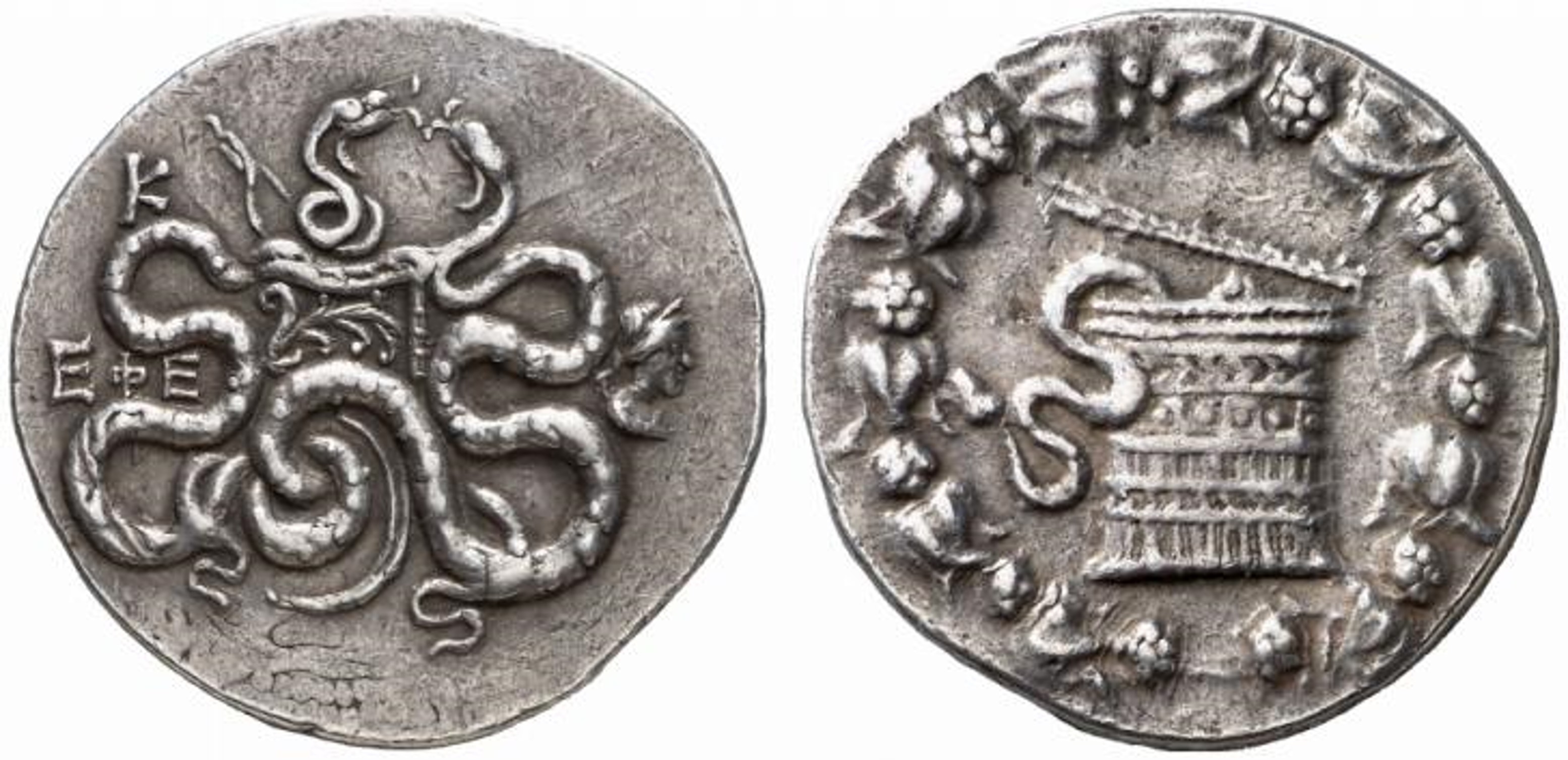1930 - Ephesus (cistophoric tetradrachm cista/bowcase) over Amphipolis (First Macedon) (Artemis/club) (Lanz, 125, Nov. 2005, 362)
From SILVER
140 BCE - 137 BCE | ΕΦΕ
Images
Overstriking coin

Ephesus_1433_Lanz.jpg [1]
Location/history
| Sale(s)Sale(s) ᵖ: | Classical Numismatic Group, MBS 72, 14 June 2006, 729 = Lanz, 125, 28 Nov. 2005, 362 | |
Overstriking coin
Description
| ObverseInscription or printing placed on the obverse.: | Cista mystica with half-open lid, from which a snake issues to left, all within ivy wreath. | ReverseInscription or printing placed on the reverse.: | ΕΦΕ (Greek) Two snakes surrounding an ornamented bow case, strap right, containing strung bow. To upper left, K. To right, head of Artemis right. |
Mint and issuing power
| MintIdentifies the place of manufacture or issue of a numismatic object.: | Ephesus | Ancient regionAncient region. | Ionia | Modern countryModern country: Turkey | AuthorityIdentifies the issuing power. The authority can be "pretended" when the name or the portrait of X is on the coin but he/she was not the issuing power. It can also be "uncertain" when there is no mention of X on the coin but he/she was the issuing power according to the historical sources: | Attalid Kingdom |
Chronology
| FromIdentifies the initial date in a range assigned in a numismatic context. 140 BCE toIdentifies the final date in a range assigned in a numismatic context.. 137 BCE | Hellenistic 323-30 BC |
Physical description
| MetalThe physical material (usually metal) from which an object is made.: Silver |
WeightWeight of the numismatic object (in grams). in grams: 12.5912.59 g <br />12,590 mg <br /> | DenominationTerm indicating the value of a numismatic object. Examples: tetradrachm, chalkous, denarius.: cistophoric tetradrachm | AxisDescribes the directional relationship between the obverse and reverse of a numismatic object.: 11 mm <br />0.1 cm <br /> |
| StandardStandard.: Cistophoric | |||
References
| Coin referenceReference of the Coin: | Coin series referenceReference to coin series study: | Kleiner 19721Kleiner 1972, Kleiner - Noe 19772Kleiner - Noe 1977, Series 33 (obv. die 44), Carbone 20203Carbone 2020 | |
| Coin series web referenceCoin series web references: | |||
Overstruck type
Description
| ObverseInscription or printing placed on the obverse.: | Diademed and draped bust of Artemis to right, at the center of a Macedonian shield ornamented with stars within crescents | ReverseInscription or printing placed on the reverse.: | MAKEΔONΩN / ΠΡΩTHΣ (Greek) Club with head to right between two lines of inscription, above, monogram, below, two monograms, all within oak wreath with ties to left, to left, thunderbolt |
Mint and issuing power
| MintIdentifies the place of manufacture or issue of a numismatic object. ᵖ: | Amphipolis | Ancient regionAncient region. ᵖ | Macedon | Modern countryModern country: Greece | AuthorityIdentifies the authority in whose name (explicitly or implicitly) a numismatic object was issued. ᵖ: | Macedonia First Meris (Roman Province), Roman Republic |
Chronology
| FromIdentifies the initial date in a range assigned in a numismatic context. 167 BCE toIdentifies the final date in a range assigned in a numismatic context.. 149 BCE | Hellenistic 323-30 BC |
Physical description
| DenominationTerm indicating the value of a numismatic object. Examples: tetradrachm, chalkous, denarius. ᵖ: | tetradrachm |
StandardStandard. ᵖ: | Attic |
References
| Coin type referenceReference to coin series study ᵖ: | HGC 3.14HGC 3.1, n° 1103 | ||
| Coin series web reference overstruckCoin series web references overstruck: | |||
Additional data
| Frequency of overstrikesFrequency of overstrikes: | rare and concentrated | Level of confidenceLevel of confidence of the identification: | sure |
| RemarksRemarks: | "Overstruck on a tetradrachm of the First Meris from the Roman Protectorate of Macedon (thunderbolt and M are visible)" "The Macedonian tetradrachms were struck on the Attic standard, so approximately 3-4 grams had to be cut from this undertype before it was restruck on the cistophoric standard" | ||
References
- ^ Kleiner, Fred S. (1972), "The dated Cistophori of Ephesus," American Numismatic Society. Museum notes, 18, p. 17-32.
- ^ Kleiner, Fred S. - Noe, Sydney P. (1977), The early Cistophoric coinage, Numismatic Studies 14, New York, 129 p., 38 pl.
- ^ Carbone, Lucia Francesca (2020), Hidden Power. Late Cistophoric Production and the Organization of Provincia Asia (128-89 BC), Numismatic Studies 42, New York, 266 p., 140 pl.
- ^ Hoover, Oliver D. (2016), Handbook of coins of Macedon and its neighbors. 3. Part I: Macedon, Illyria, and Epeiros, sixth to first centuries BC, Lancaster, 437 p.
